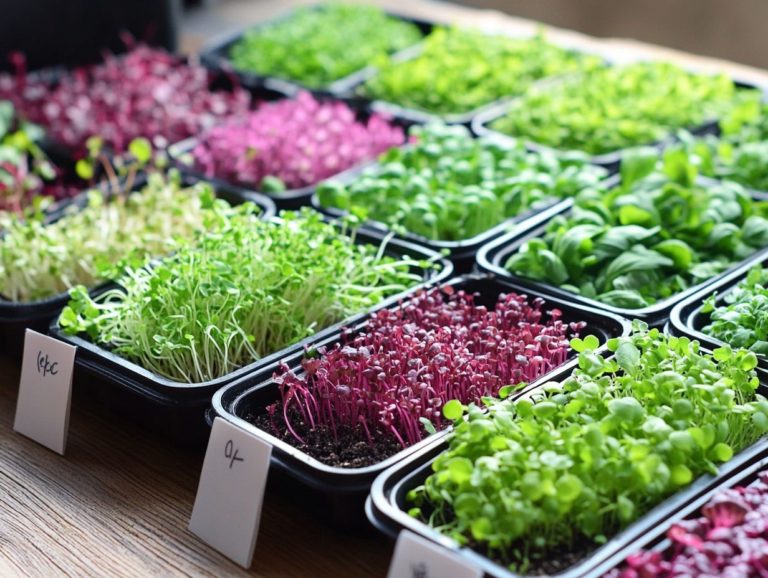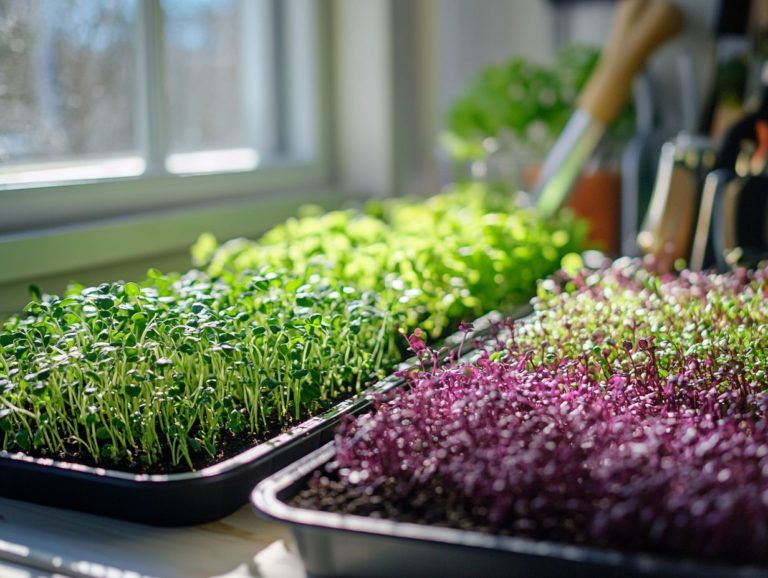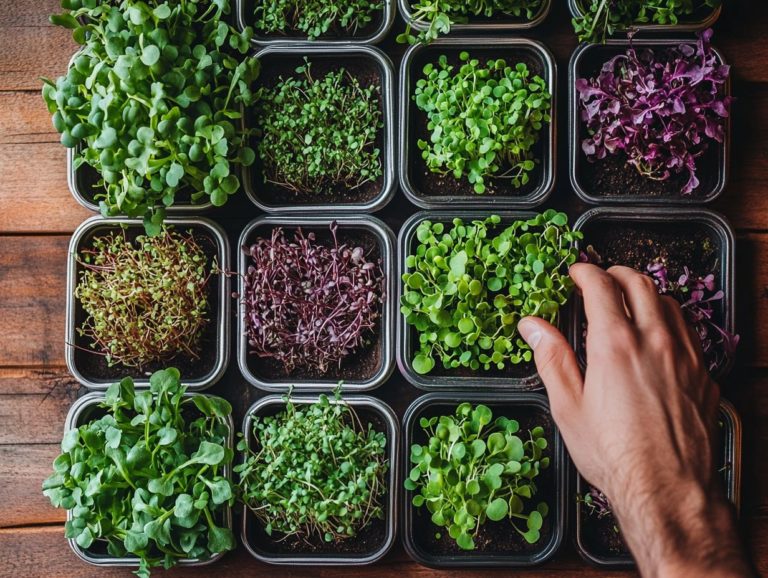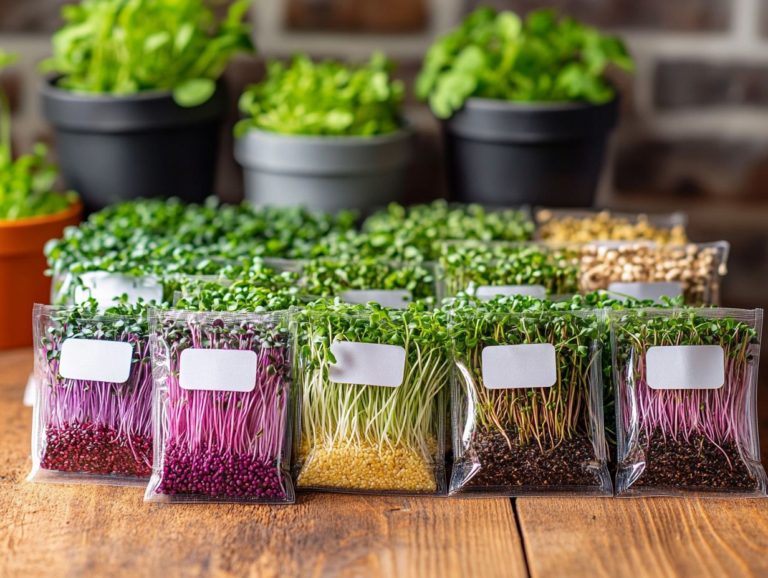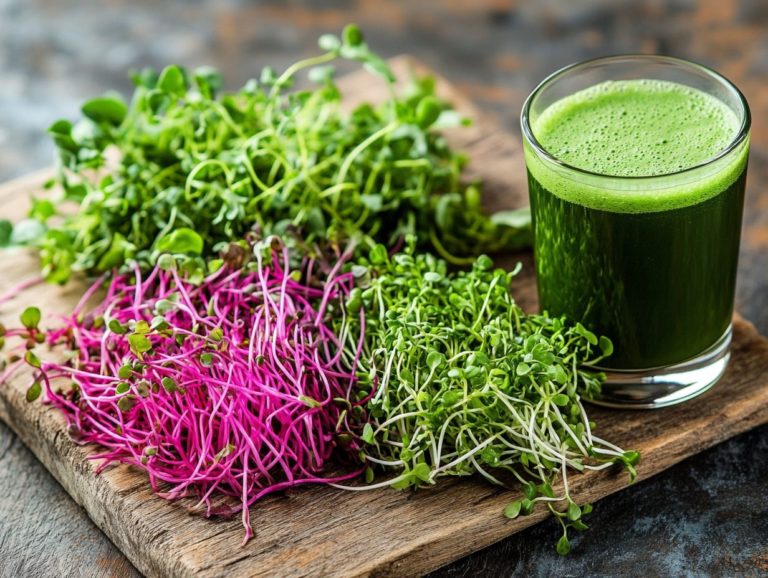How to Use Microgreens in Cooking?
Microgreens have revolutionized the culinary landscape. They add vibrant color and flavor while providing a nutritional boost.
This article explores microgreens, their types, and the unique advantages they bring to your dishes.
Learn how to easily incorporate these little gems into your cooking. You can even grow your own at home and avoid common mistakes.
Whether you’re a seasoned chef or a home cook, you’ll find inspiration to elevate your meals with these extraordinary greens.
Contents
Key Takeaways:
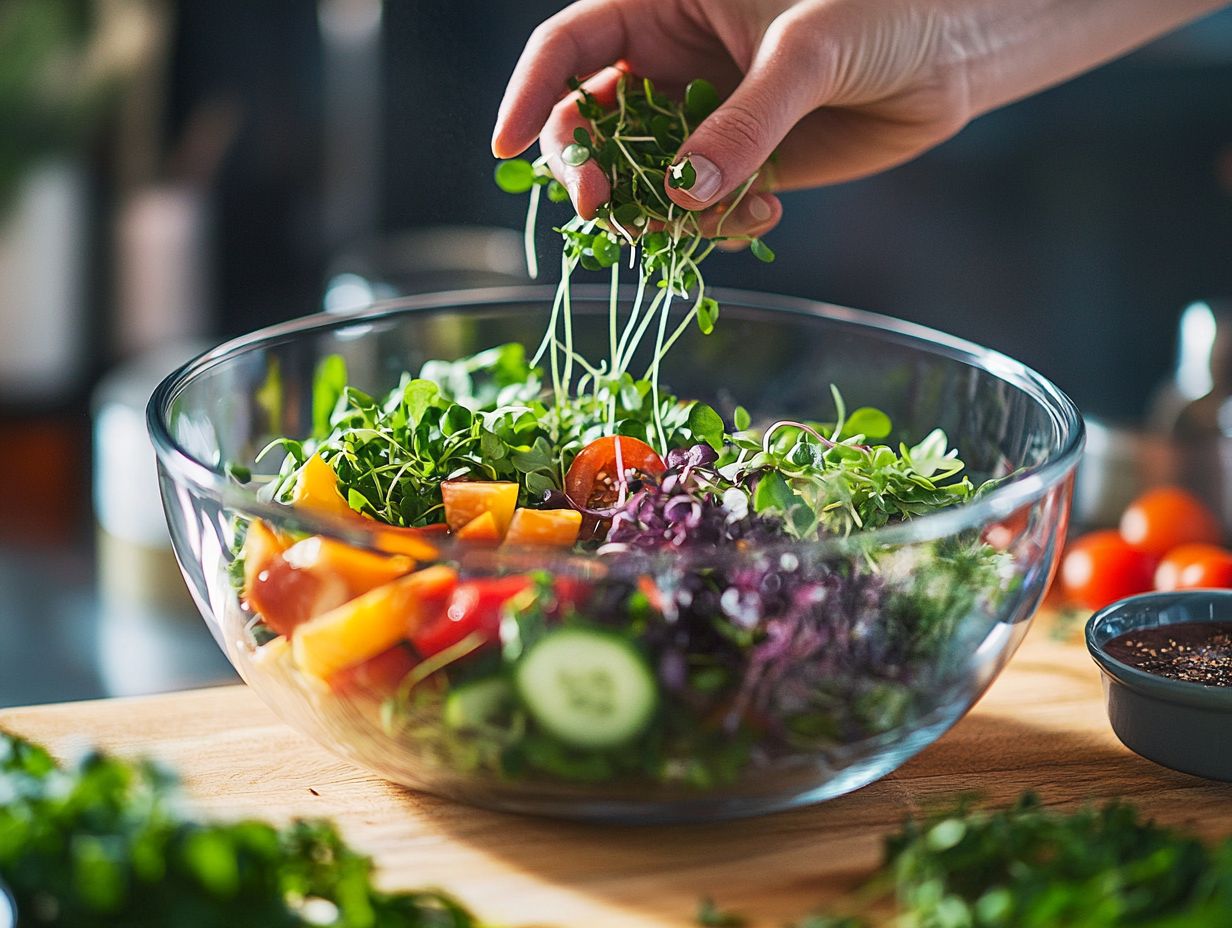
- Explore various types of microgreens, from herbs to vegetables, that add flavor and color to your dishes.
- Microgreens not only enhance presentation but also offer nutritional benefits, making your meals tastier.
- Incorporate microgreens into your cooking with simple tips and learn to grow them at home while avoiding common handling mistakes.
What are Microgreens?
Microgreens are tiny plants harvested right after their first true leaves appear. They bring an exciting mix of flavors, textures, and colors to your plate.
These greens are popular in kitchens for boosting meals’ nutritional value and visual appeal. Consider varieties like arugula, basil, and radish microgreens they’re just the beginning of your options!
With concentrated health benefits and versatile uses, microgreens are a fantastic addition for both home cooks and professional chefs.
Defining Microgreens and Their Varieties
Microgreens include various young plants, each celebrated for its flavor and nutrition. They can elevate your meals with distinct flavor profiles.
For instance, arugula microgreens add a peppery kick, while different basil types provide sweet aromas. Pea shoots offer a crisp taste that complements salads and sandwiches. Radish microgreens deliver a spicy note, perfect for tacos or savory omelets.
These tiny plants also pack a lot of healthy nutrients, including vitamins, minerals, and antioxidants that support your overall health.
Benefits of Using Microgreens in Cooking
Incorporating microgreens into your meals enhances their nutritional value. These tiny powerhouses add essential vitamins and minerals to your diet.
They can boost your immune system and aid digestion, providing numerous health benefits. Whether crafting a fresh microgreens salad, a gourmet sandwich, or a nutrient-rich smoothie, their role in healthy eating can spark your culinary creativity.
Nutritional Value and Culinary Uses

Microgreens are far more than mere garnishes; they are a great source of nutrition, often packing more vitamins and minerals than their fully grown counterparts. In fact, certain varieties can deliver up to 40 times more nutrients, making them an exceptional choice for elevating your culinary creations. Rich in vitamins such as A, C, E, and K, these tiny greens enhance everything from salads to smoothies.
Consider arugula microgreens, which add a delightful peppery kick to a vibrant summer salad, or sunflower microgreens, which introduce a satisfying crunch to stir-fries or sandwiches. By incorporating these full of nutrients greens into your recipes, you not only elevate the dish’s visual appeal but also foster a more nutritious diet. For more information on different types, check out microgreen varieties and their culinary uses.
How to Incorporate Microgreens into Your Dishes
Microgreens can transform your dishes! Incorporating them into your meals can truly elevate both the flavor and nutritional profile, making them a critical ingredient for your culinary endeavors.
Whether you re crafting a refreshing microgreens salad, assembling a gourmet sandwich, or blending a nutrient-rich smoothie, the possibilities with microgreens are virtually limitless. Their vibrant colors and diverse flavors allow them to shine as garnishes, toppings, or even the main part of your meal.
Mastering how to use microgreens can enhance your cooking and allow you to fully enjoy their myriad health benefits.
Tips for Adding Microgreens to Recipes
When you add microgreens to your recipes, it s essential to consider their delicate nature and find the best ways to showcase their flavors without overshadowing the dish.
These vibrant mini greens can elevate many meals by imparting a fresh burst of flavor and providing an appealing visual contrast. To enhance a salad, for example, mix a handful of peppery arugula microgreens with sweet cherry tomatoes and creamy avocado, allowing the microgreens to shine as a flavorful garnish. For more inspiration, explore the top microgreen varieties for gourmet cooking.
For sandwiches, they pair beautifully with sliced turkey or avocado, introducing an unexpected crunch and a nutrient boost. Incorporating them into soups or omelets just before serving can infuse a delightful freshness.
Don t hesitate to experiment with different types; you may discover unique combinations, like blending basil microgreens into a pesto or topping a pizza with radish greens.
Growing Your Own Microgreens at Home
Growing your own microgreens at home is not just rewarding; it s a fulfilling journey that lets you savor fresh greens straight from your kitchen. With an array of options available from microgreens kits to subscription services it s never been simpler to embark on this nutritious endeavor.
Cultivating your own greens grants you access to the freshest ingredients and brings the joy of nurturing your plants from seed to harvest. By grasping the essential steps and optimal conditions for growing microgreens, you position yourself for success in this delightful and enriching hobby.
Step-by-Step Guide to Growing Microgreens
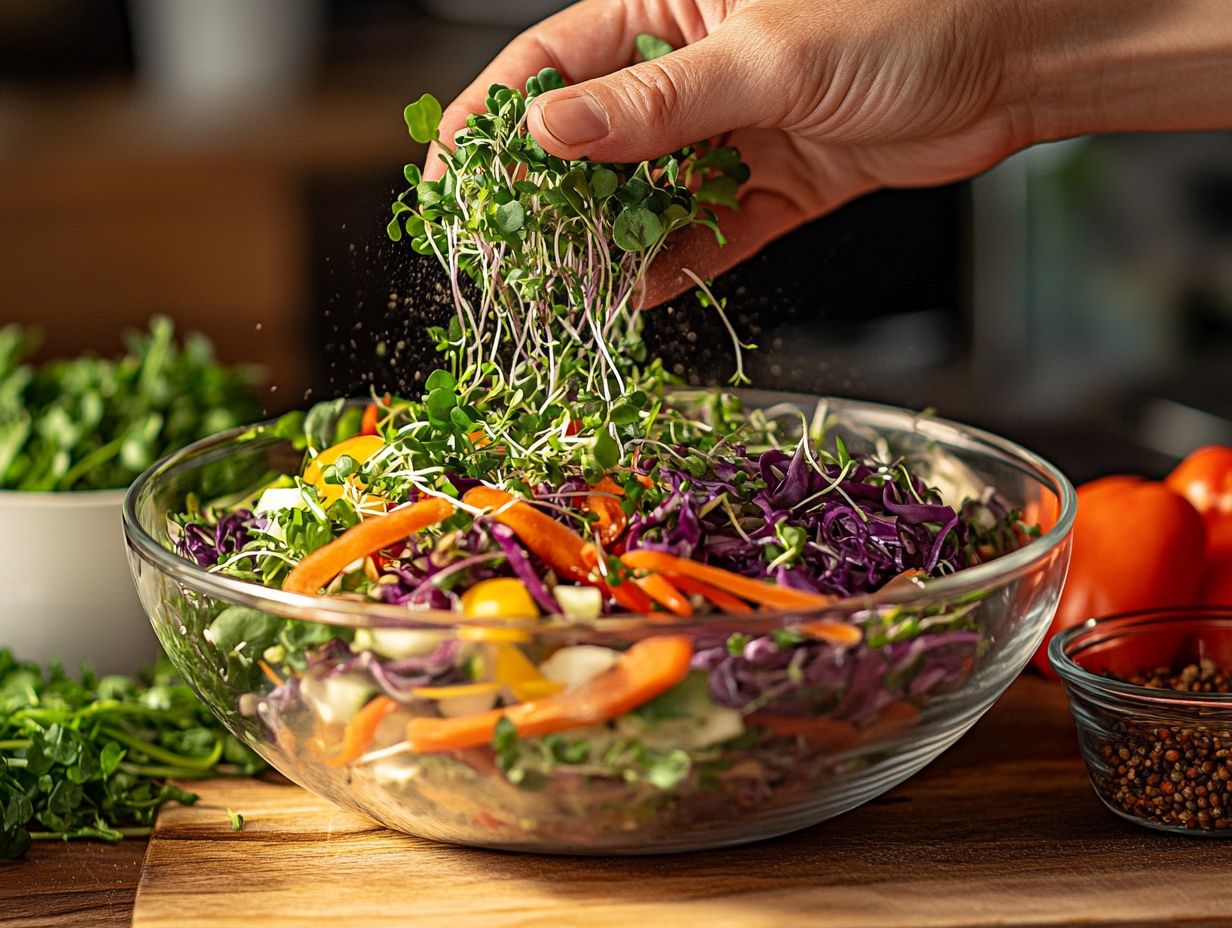
To successfully grow microgreens, embark on a carefully crafted journey that guides you through every step, from selecting the perfect seeds to harvesting your fresh greens.
This comprehensive tutorial ensures that even those new to home farming can cultivate flavorful, nutritious greens effortlessly. To enhance their taste, consider exploring ways to enhance flavor in microgreens. Start by choosing the right microgreens kit that offers a variety of seeds; popular options include radish, broccoli, and sunflower.
Next, prepare the soil with care, ensuring it is rich in nutrients and well-prepared to foster healthy growth. Understanding the significance of proper watering techniques is crucial; these delicate plants thrive in a moist environment, but be mindful not to overwater.
When the moment arrives to harvest, using precise techniques will maximize the flavor and texture of your greens, allowing you to relish the fruits of your labor in a wide array of dishes.
Start growing your own microgreens today and enjoy fresh flavors in your meals!
Common Mistakes to Avoid When Using Microgreens
Microgreens can elevate your meals. However, avoid certain pitfalls to fully unlock their rich flavor and nutritional potential.
Tips for Proper Handling and Storage
Handle microgreens with care to preserve their freshness and flavor. Gently rinse them under cool water to remove soil or residues, but don t soak them.
After washing, pat them dry with a paper towel or use a salad spinner. This prevents moisture buildup, which can cause spoilage.
Opt for a breathable container, like a perforated bag or a container lined with a damp paper towel, to allow for air circulation. Store them in the refrigerator s crisper drawer for optimal freshness, where the humidity is slightly higher and the temperature is cooler, perfectly supporting their delicate nature.
Frequently Asked Questions
What are microgreens and how can I use them?

Microgreens are young plants harvested shortly after they sprout. They add great flavor and nutrients to dishes. You can add microgreens to salads, sandwiches, or even smoothies!
Where can I buy microgreens for cooking?
You can purchase microgreens from your local grocery store, farmer’s market, or even grow them at home. Some restaurants offer microgreens as a side or garnish on their dishes.
How do I store microgreens for later use?
Proper storage helps maintain microgreens’ freshness. Place them in a sealed container in the refrigerator. They should last for up to a week, but it s best to use them within a few days for maximum freshness.
Can I cook with microgreens?
Microgreens are typically used as a raw ingredient, but you can also cook them in certain dishes. They are best added to dishes near the end of the cooking process, as they can lose their flavor and texture if overcooked.
Do microgreens have any health benefits?
Yes! Microgreens are full of vitamins, minerals, and beneficial compounds that fight off illness. They are also a good source of fiber and can help boost your immune system. Adding microgreens to your dishes is an easy way to incorporate more nutrients into your diet.
Are there any specific microgreens that work best in cooking?
While all microgreens can be used in cooking, some are more popular than others due to their flavor profiles. Commonly used microgreens include arugula, basil, cilantro, and radish. However, feel free to experiment and find your favorite microgreens!
Try adding microgreens to your next meal for a boost of flavor and nutrition!

